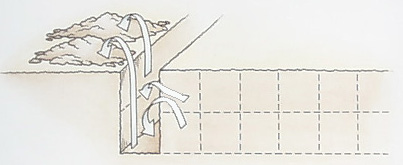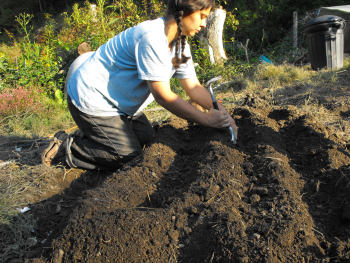
Double digging
 Another no-till technique is double-digging, a
slightly complicated method of breaking up the soil to a depth of two
feet without inverting the soil layers. Double-digging is
extremely laborious, but can result in porous soil that greatly
increases vegetable yields, especially in heavy clay soil like
ours. After double-digging, soil doesn't need to be worked for
several years, much like the surface cultivation system.
Another no-till technique is double-digging, a
slightly complicated method of breaking up the soil to a depth of two
feet without inverting the soil layers. Double-digging is
extremely laborious, but can result in porous soil that greatly
increases vegetable yields, especially in heavy clay soil like
ours. After double-digging, soil doesn't need to be worked for
several years, much like the surface cultivation system.
 We used a modified method of double-digging to create
our raised beds. First, Mark tilled up our topsoil, being
careful not to go too deep (not a problem with the tiny tiller I had
him working with the first year.) Then I laid out aisles and
shoveled the loose soil from the aisles to the side to create raised
beds. The result is a double thickness of loose topsoil without
as much of the back-breaking labor of double-digging. The
grassy/clovery aisles between our raised beds produce high quality
mulch, protect the soil from erosion, and promote water infiltration
(rather than runoff) during heavy rains.
We used a modified method of double-digging to create
our raised beds. First, Mark tilled up our topsoil, being
careful not to go too deep (not a problem with the tiny tiller I had
him working with the first year.) Then I laid out aisles and
shoveled the loose soil from the aisles to the side to create raised
beds. The result is a double thickness of loose topsoil without
as much of the back-breaking labor of double-digging. The
grassy/clovery aisles between our raised beds produce high quality
mulch, protect the soil from erosion, and promote water infiltration
(rather than runoff) during heavy rains.
After the first
year, we put the rototiller away and spend the rest of our time
weeding, applying manure, and mulching. I'd recommend our bed system
to anyone, with just one caveat. Raised beds don't work well in
sandy soil or extremely hot climates where the soil will dry out
rapidly. Of course, if you have sandy soil, increasing soil
porosity won't be a problem for you anyway.
This post is part of our lunchtime series reviewing Robert Kourik's Designing and Maintaining your
Edible Landscape Naturally.
Read all of the entries:
|
Want more in-depth information? Browse through our books.
Or explore more posts by date or by subject.
About us: Anna Hess and Mark Hamilton spent over a decade living self-sufficiently in the mountains of Virginia before moving north to start over from scratch in the foothills of Ohio. They've experimented with permaculture, no-till gardening, trailersteading, home-based microbusinesses and much more, writing about their adventures in both blogs and books.
Want to be notified when new comments are posted on this page? Click on the RSS button after you add a comment to subscribe to the comment feed, or simply check the box beside "email replies to me" while writing your comment.
